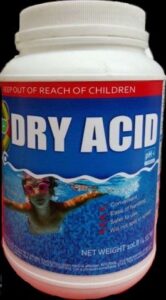Lowering PH in swimming pool water with various products
March 28, 2016
Reprinted with permission from Kim Skinner of OnBalance :
:
There are some differences between muriatic acid (HCl), dry acid (sodium bisulfate, NaHSO4), and sulfuric acid (H2SO4) in the treatment of swimming pool water. We will attempt to review and clarify these three types of acids.
When added to water, all three of these acids increase the amount of hydrogen ions (also known as hydronium ions) present in water. These hydrogen ions immediately react with alkaline components in pool water such as bicarbonate (alkalinity) ions and convert them into carbonic acid, thus reducing the alkalinity in the water and lowering the pH. Also, when added, these three acids add a byproduct to the water. With muriatic, it is the chloride ions (Cl), with dry acid and sulfuric acid, the bi-product is sulfate (SO4) ions.
Muriatic acid (also known as hydrochloric acid) is probably the most common and most used type of acid for lower pH and alkalinity in pool water, and performing acid washes. The strength that is purchased for pool water use is normally 31.45%, but sometimes is marketed at 20% and even 10% in supermarkets and hardware stores.
Dry acid (sodium bisulfate) has become more popular in recent years, probably because it is easier and safer to use. Its strength is usually about 93-94%. While sodium bisulfate may have a higher strength percentage, it still costs more to use than muriatic acid. For every gallon of muriatic acid, it requires about 10.5 lbs. of sodium bisulfate to do the same job.
Some service techs use sulfuric acid to lower pH and alkalinity and also for acid washes. There are some that claim that sulfuric acid removes copper stains more effectively than does muriatic acid. The typical strength for sulfuric acid purchased in one gallon containers is around 38%. While the percentage strength of sulfuric acid (38.5%) is higher than muriatic acid (31.5%), they are nearly equal in pH and alkalinity reduction gallon for gallon. So the price per gallon between the two acids may be a deciding factor when considering which to use.
There is the possibility of purchasing a higher strength sulfuric acid in bulk containers which has the strength of 93% or higher. This high strength acid is about 3.5 times stronger than muriatic acid. However, we advise to NOT use 93% sulfuric acid due to it being very hazardous to use. It is extremely corrosive, more so than muriatic acid and sodium bisulfate.
Also, other potential problems to consider when using sulfuric acid (including sodium bisulfate) is that they add sulfates to the water. In time, the content of sulfate increases in the water, which then can combine with calcium ions and form a precipitate crystal. Calcium sulfate deposits can be particularly difficult to remove from pools. Regular acid washes do not have much of an effect on removing this deposit.
High sulfate contents in pool water can also be more corrosive to cement finishes as it builds up in high concentrations over time.
The following are formulas on how much of the three acids to add for lowering alkalinity:
For muriatic acid, it is Volume (of the water) divided by 125,000 then multiplied by the ppm desired reduction in alkalinity which then gives the amount of QUARTS to add.
For sodium bisulfate (dry acid), it is Volume divided by 47,000 then multiplied by the ppm desired reduction in alkalinity which then gives the POUNDS to add.
For 38.5% sulfuric acid, it is Volume divided by 128,000 then multiplied by the ppm desired reduction in alkalinity which then gives the QUARTS to add.
onBalance March 2016
